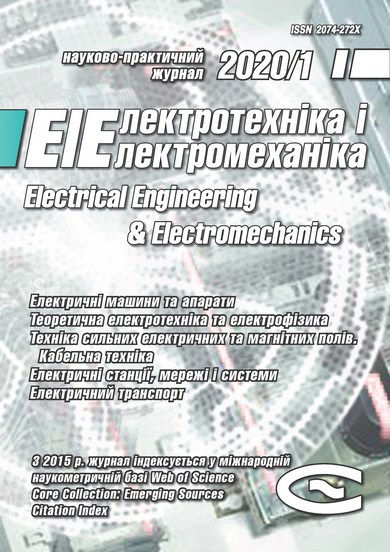TURBOGENERATOR ROTOR HEATING IN PRESENCE OF ROTOR WINDING DEFECTS AND EXCITATION CURRENT FORCING
DOI:
https://doi.org/10.20998/2074-272X.2020.1.02Keywords:
turbogenerator, rotor winding, temperature, temperature gradient, short circuit, clogging of cooling channels, excitation forcingAbstract
Purpose. Research of the TGV-200 turbogenerator rotor heating in case of rotor winding damages, which occur as a result of prolonged operation of the turbogenerator, namely - clogging of the ventilation channels of the rotor winding and the occurrence of short circuits of the rotor windings. Particular attention is paid to heating during short-term increasing of the excitation current, which is performed to keep the generator in synchronous mode of operation. Methods. Field mathematical models are used. Results. It is determined that the clogging of the rotor winding ducts has a greater effect on the rotor heating compared to the short circuits of the individual windings of the rotor winding. It was defined that increasing of the excitation current within the limits regulated by the current standards of the turbogenerators operation becomes impossible with clogging of a small number of ventilation channels of the rotor winding, which impairs the efficiency of the turbogenerator and requires its output to repair. Scientific novelty. A mathematical model of rotor heating is developed in case of typical damages of the rotor winding. Practical value. The areas in the rotor where the temperatures and temperature gradients reach the highest values was determined, which allows to recommend the locations of the optimal temperature sensors placements.References
Kuchinskiy K.A. Analysis of the temperature field of the of 300 MW turbogenerator rotor with asymmetry in the cooling of the slot zone. Technical electrodynamics, 2013, vol.4, pp. 59-66. (Rus).
Fedorenko G.M., Kolesnik G.A. High-voltage insulation system with increased thermal conductivity for turbogenerators. Works of institute of electrodynamics National Academy of Sciences of Ukraine, 2010, no.25, pp. 38-41. (Rus).
Fedorenko H.M., Vaskovskyi Yu.M., Saratov V.O. Temperature distribution in the rotor in case of excitation current forcing in the Q-winding of the modernizing TGV-300 turbogenerator. News of power engineering, 1998, no.4, pp. 33-39. (Ukr).
Filippov I.V. Teploobmen v electrisnyh masynah [Heat transfer in electric machines].Leningrad, Energoizdat Publ., 1986. 256 p. (Rus).
Shulzhenko N.G., Gontarovsky P.P., Protasova T.V. Influence of non-uniformity of heat dissipation in the generator rotor on its thermal stress state. Aerospace Engineering and Technology, 2007, no.8(44), pp. 135-139.(Rus).
Lu Y., Li W., Ma X., Jin H.Y. Numerical simulation of temperature field in rotor of large turbogenerator with air-coolant. Proceedings of the Chinese Society of Electrical Engineering, 2007, vol.27, no.12, pp. 7-13.
Weili L., Xuefeng Y., Debao G., Yongli F. Calculation and analysis of fluid flow and heat transfer of air cooled turbogenerator with multipath ventilation. Transactions of China Electrotechnical Society, 2009, vol.24, no.12, pp. 24-31.
Singh A.N., Doorsamy W., Cronje W. Thermographical analysis of turbogenerator rotor. Electric Power Systems Research, 2018, vol.163, pp. 252-260. doi: 10.1016/j.epsr.2018.06.019.
Irwanto B., Eckert L., Prothmann T. Thermal unbalance behaviour of turbogenerator rotors. Proceedings of the 9th IFToMM International Conference on Rotor Dynamics. Springer, Cham, 2015, pp. 2231-2242. doi: 10.1007/978-3-319-06590-8_183.
Weili L., Chunwei G., Ping Z. Calculation of a complex 3-D model of a turbogenerator with end region regarding electrical losses, cooling, and heating. IEEE Transactions on Energy Conversion, 2011, vol.26, no.4, pp. 1073-1080. doi: 10.1109/tec.2011.2161610.
Downloads
Published
How to Cite
Issue
Section
License
Copyright (c) 2020 Yu. M. Vaskovskyi, O. A. Geraskin

This work is licensed under a Creative Commons Attribution-NonCommercial 4.0 International License.
Authors who publish with this journal agree to the following terms:
1. Authors retain copyright and grant the journal right of first publication with the work simultaneously licensed under a Creative Commons Attribution License that allows others to share the work with an acknowledgement of the work's authorship and initial publication in this journal.
2. Authors are able to enter into separate, additional contractual arrangements for the non-exclusive distribution of the journal's published version of the work (e.g., post it to an institutional repository or publish it in a book), with an acknowledgement of its initial publication in this journal.
3. Authors are permitted and encouraged to post their work online (e.g., in institutional repositories or on their website) prior to and during the submission process, as it can lead to productive exchanges, as well as earlier and greater citation of published work.





